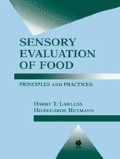Abstract
How is the goodwill of a consumer to be earned and maintained in a competitive marketplace? One strategy is to ensure that the consumer perceives, through the senses, the characteristics that make the company’s product superior to competitors’ products, and thus more desirable. Furthermore, this perception must be maintained to build brand loyalty and to ensure repurchase. The sustainability of the perception of quality is important long after the initial rush of interest from advertising claims and promotions that surround a new product introduction. The purpose of this chapter is to discuss the techniques for consumer product testing in the field on a blind-labeled basis that ensures the sustainable perception of positive product characteristics.
When all is said and done, this business is nothing but a symbol and when we translate this we find that it means a great many people think well of its products and that a great multitude has faith in the integrity of the men who make this product. The goodwill of the people is the only enduring thing in any business. It is the sole substance.... The rest is shadow—H. S. Johnson, Profit Sharing Day, 12/24/27.
Access this chapter
Tax calculation will be finalised at checkout
Purchases are for personal use only
Preview
Unable to display preview. Download preview PDF.
References
Allison, R.L., and Uhl, KP. 1964. Influence of beer brand identification on taste perception. Journal of Marketing Research, 1, 36–39.
Anon. 1974. Testing in the “real” world. The Johnson Magazine. S.C. Johnson Wax, Racine, WI.
Armstrong, J.S. 1975. Monetary incentives in mail surveys. Public Opinion Quarterly, 39, 111–116.
Bishop, G.F., Oldendick, R.W., and Tuchfarber, A.J. 1982. Effects of presenting one vs. two sides of an issue in survey questions. Public Opinion Quarterly, 46, 69–85.
Blair, E. 1980. Using practice interviews to predict interviewer behaviors. Public Opinion Quarterly, 44, 257–260.
Boyd, H.W., Westfall, R., and Stasch, S.F. 1981. Marketing Research. Irwin, Homewood, IL.
Brunner, J.A., and Brunner, G.A. 1971. Are voluntarily unlisted telephone sub-scribers really different? Journal of Marketing Research, 8, 121–124.
Cardello, A.V., and Sawyer, F.M. 1992. Effects of disconfirmed consumer expecta-tions on food acceptability. Journal of Sensory Studies, 7 (4), 253–277.
Case, P.B. 1971. How to catch interviewer errors. Journal of Marketing Research, 11, 39–43.
Cochran, W.G., and Cox, G.M. 1957. Experimental Designs. Wiley, New York
Dillman, D.A. 1978. Mail and Telephone Surveys: the Total Design Method. Wiley, New York.
Dohrenwend, B.S., Colombos, J., and Dohrenwend, B.P. 1968. Social distance and interviewer effects. Public Opinion Quarterly, 3, 410–422.
El Gharby, A.E. 1995. Effects of nonsensory information on sensory judgments of no-fat and low-fat foods: influences of attitude, belief, eating restraint and information. M.Sc. thesis, Cornell University.
Furse, D.H., Stewart, D.W., and Rados, D.L. 1981. Effects of foot-in-the-door, cash incentives and follow-ups on survey response. Journal of Marketing Research, 18, 473–478.
Gacula, M.C., Rutenbeck, S.K., Campbell, J.F., Giovanni, M.E., Gardze, C.A., and Washam, R.W. 1986. Some sources of bias in consumer testing. Journal of Sensory Studies, 1, 175–182.
Groves, R.M. 1978. On the mode of administering a questionnaire and responses to open-end items. Social Science Research, 7, 257–271.
Hays, W.L. 1973. Statistics for the Social Sciences. Holt, Rinehart & Winston, New York
Jellinek, J.S. 1975. The Use of Fragrance in Consumer Products. Wiley, New York
Johnson, S.C. 1986. Reflections on 100 years. Johnson Wax Magazine, 59 (1), 8–11
Lawless, H.T. 1994. Getting results you can trust from sensory evaluation. Cereal Foods World, 39 (11), 809–814.
Lawless, H.T. and Malone, G.J. 1986. A comparison of scaling methods: sensitivity, repli-cates and relative measurement. Journal of Sensory Studies, 1, 155–174.
Payne, S.L. 1951. The Art of Asking Questions. Princeton University Press, Princeton, NJ.
Rucker, M.H., and Arbaugh, J.E. 1979. A comparison of matrix questionnaires with standard questionnaires. Educational and Psychological Measurement, 39, 637–643.
Rugg, D. 1941. Experiments in wording questions: II. Public Opinion Quarterly, 5, 91–92.
Schaefer, E.E. 1979. ASTM Manual on Consumer Sensory Evaluation. STP 682. American Society for Testing and Materials, Philadelphia.
Singer, E., and Frankel, M.R. 1982. Informed consent procedures in telephone interviews. American Sociological Review, 47, 416–427.
Sobal, J. 1982. Disclosing information in interview introductions: methodological consequences of informed consent. Sociological and Social Research, 66, 348–361.
Sorensen, H. 1984. Consumer Taste Test Surveys: A Manual. Sorensen, Corbett, OR
Stone, H., and Sidel, J.L. 1993. Sensory Evaluation Practices. Academic, San Diego.
Author information
Authors and Affiliations
Rights and permissions
Copyright information
© 1999 Springer Science+Business Media New York
About this chapter
Cite this chapter
Lawless, H.T., Heymann, H. (1999). Consumer Field Tests and Questionnaire Design. In: Sensory Evaluation of Food. Food science text series. Springer, Boston, MA. https://doi.org/10.1007/978-1-4419-7452-5_14
Download citation
DOI: https://doi.org/10.1007/978-1-4419-7452-5_14
Publisher Name: Springer, Boston, MA
Print ISBN: 978-1-4757-6499-4
Online ISBN: 978-1-4419-7452-5
eBook Packages: Springer Book Archive

